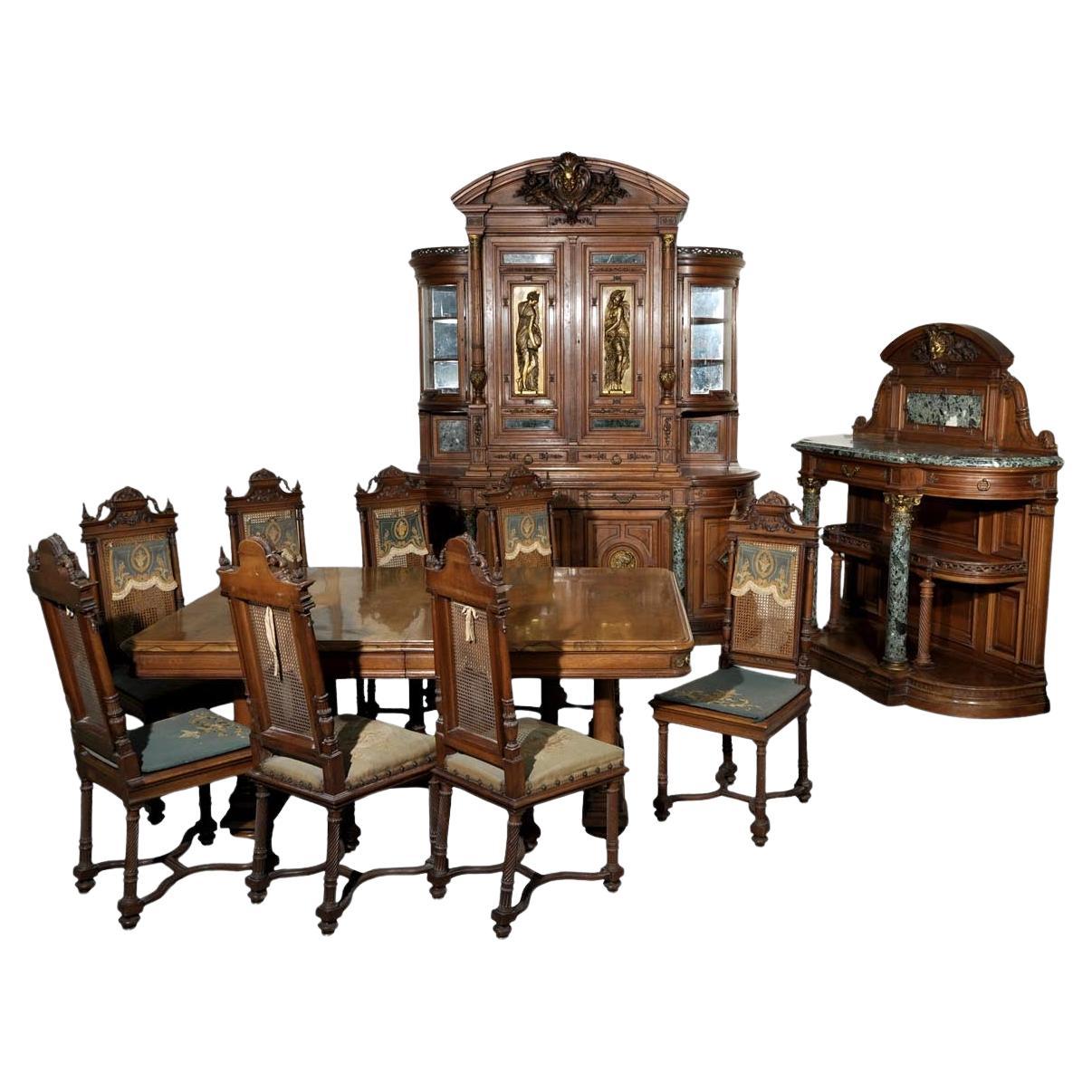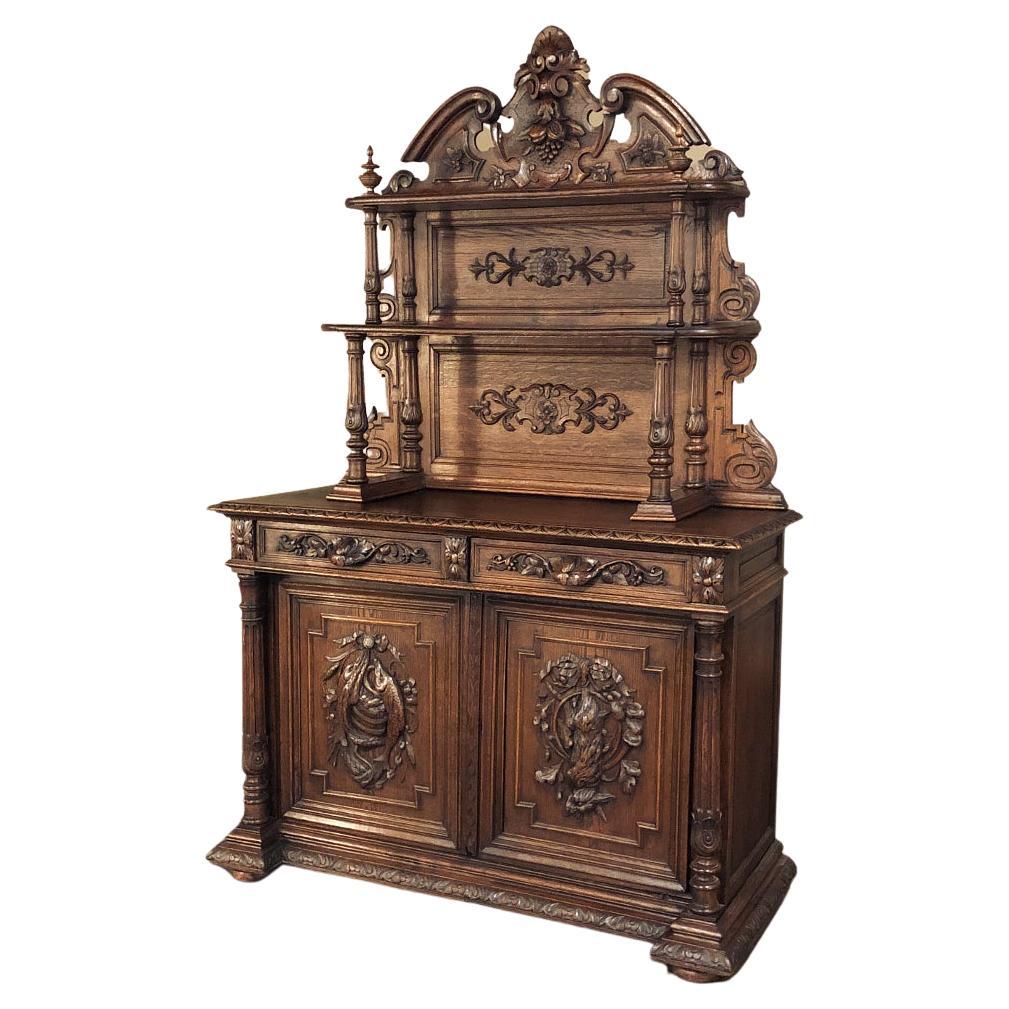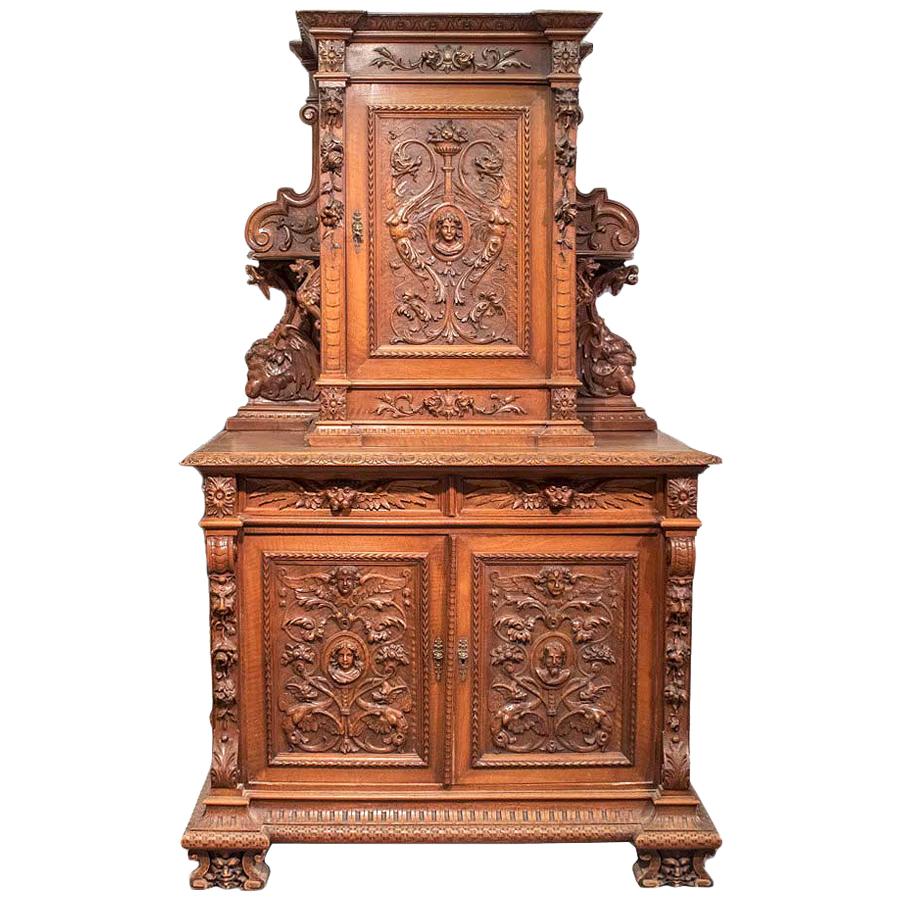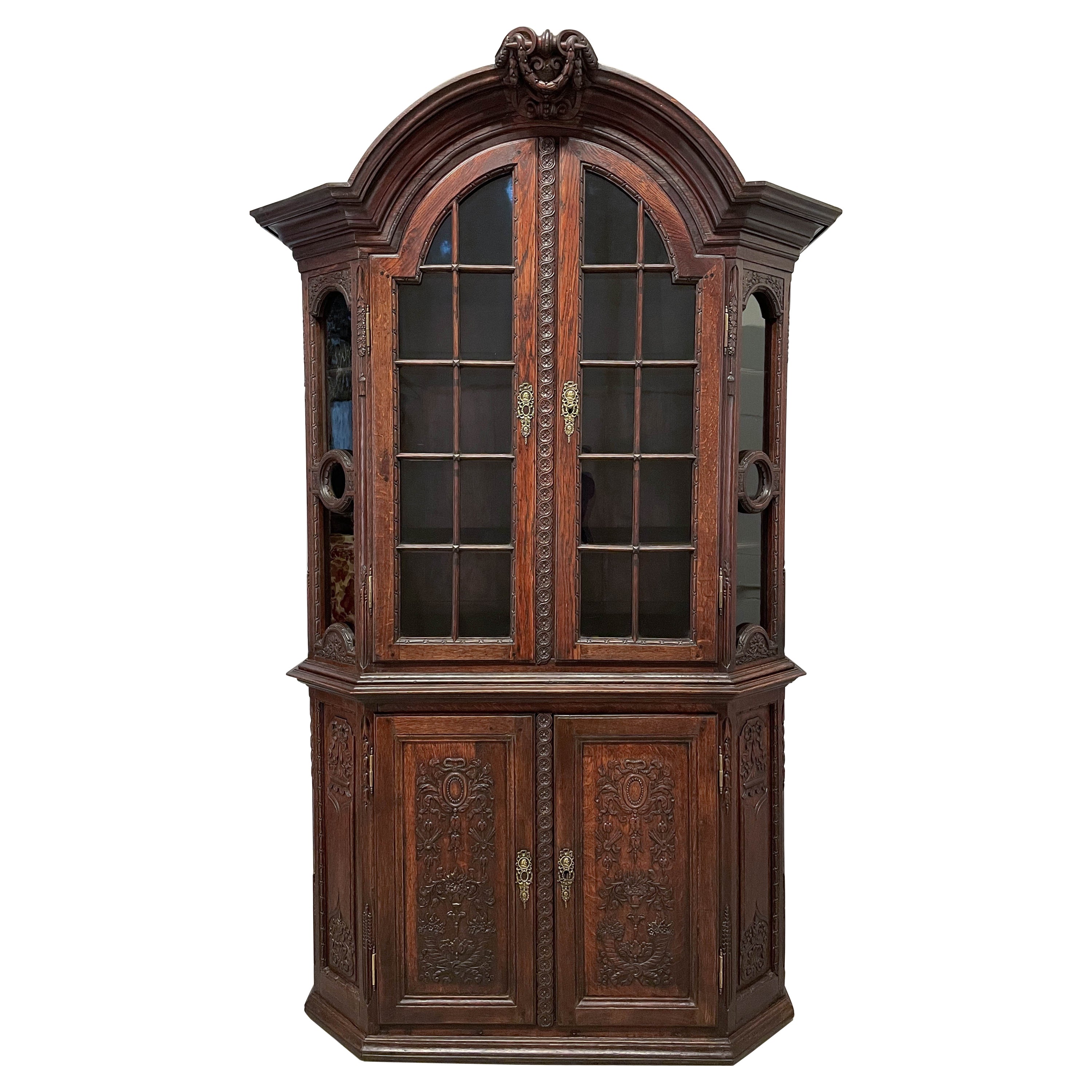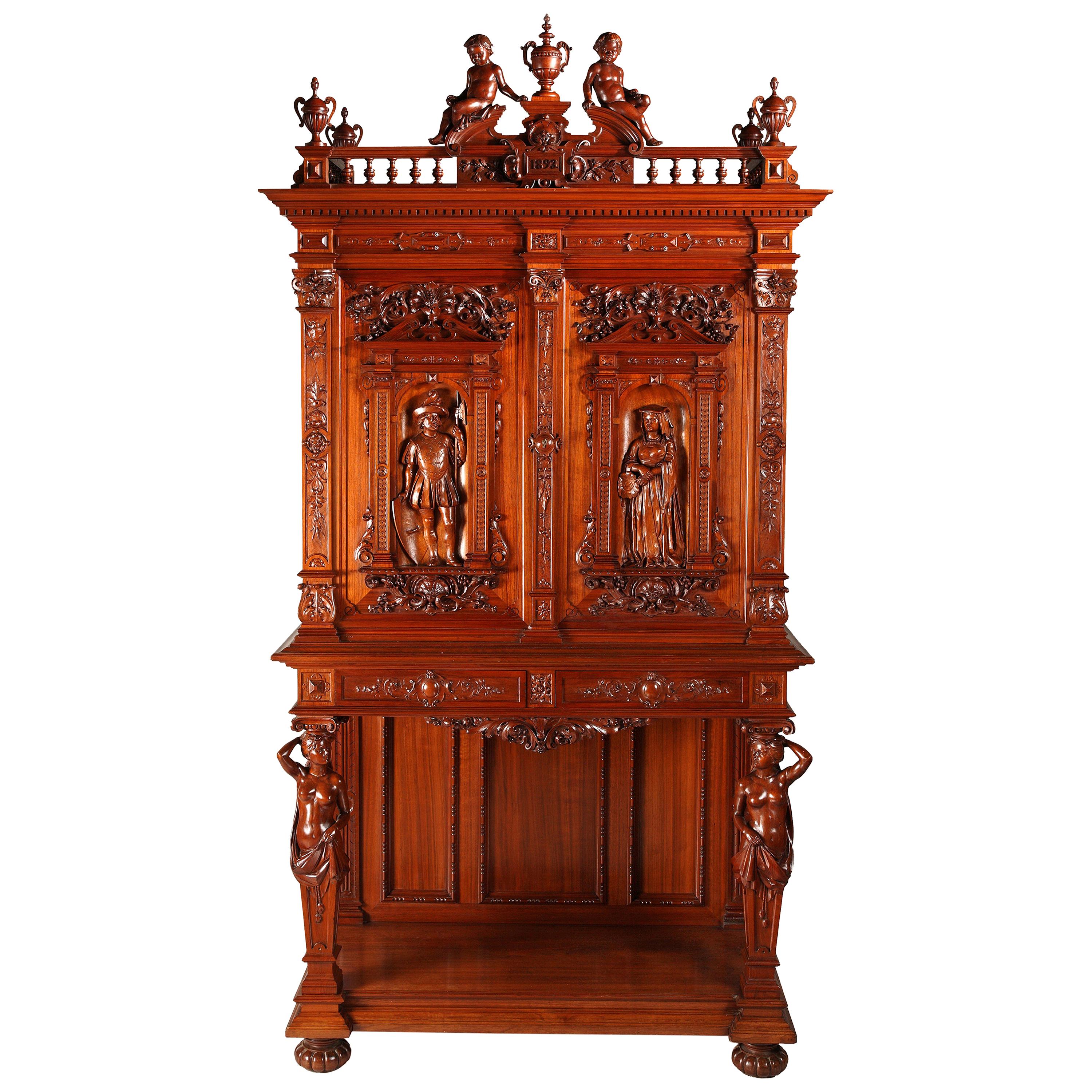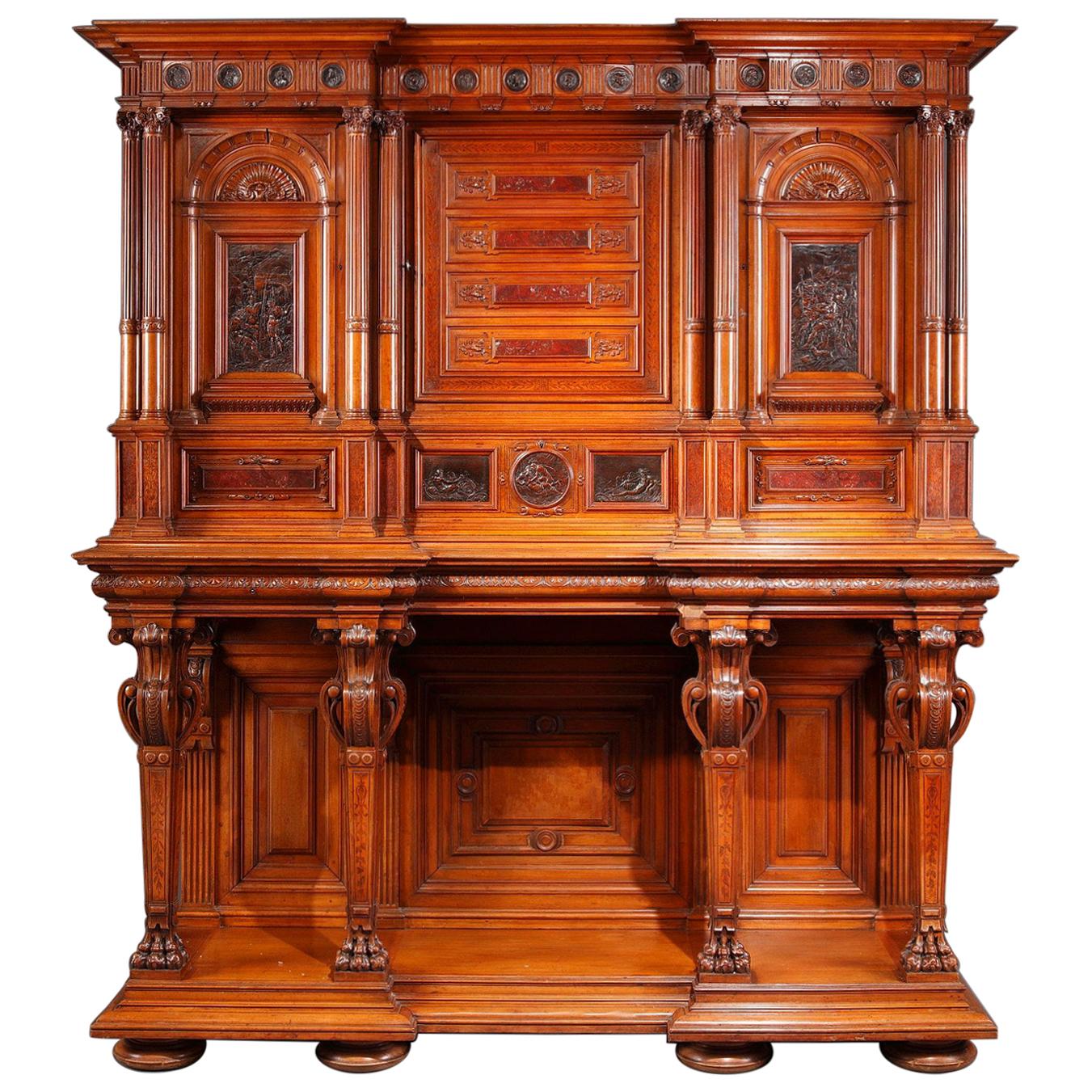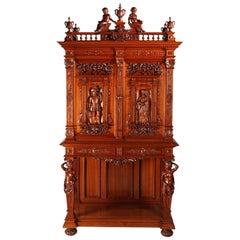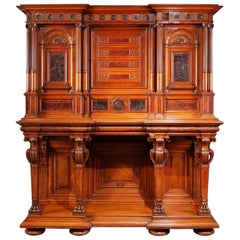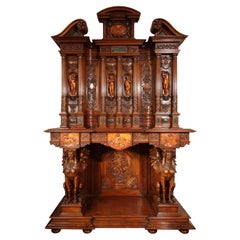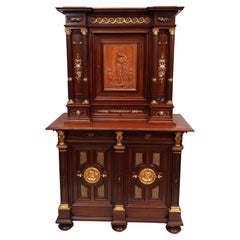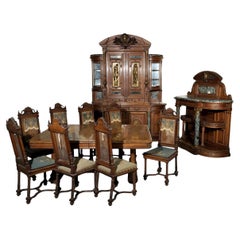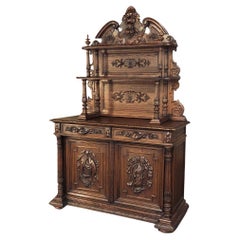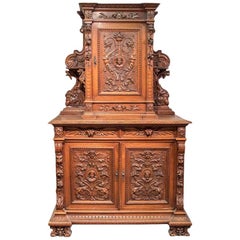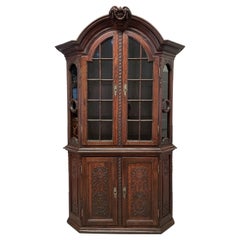Items Similar to Neo-Renaissance Dining Room Set Att. to Barbedienne, Meynard & Sevin, circa 1890
Want more images or videos?
Request additional images or videos from the seller
1 of 21
Neo-Renaissance Dining Room Set Att. to Barbedienne, Meynard & Sevin, circa 1890
$838,938.44per set
£632,713.11per set
€720,000per set
CA$1,159,905.38per set
A$1,299,289.13per set
CHF 682,433.64per set
MX$15,798,938.24per set
NOK 8,641,837.77per set
SEK 8,203,427.83per set
DKK 5,481,111.18per set
About the Item
Display sideboard : height : 285 cm (112 in.) ; width : 215 cm (84,6 in) ; depth : 70 cm (27,5 in.)
Table (without extension) : height : 76 cm (29,9 in.) ; width : 170 cm (66,9 in.) ; depth : 120 cm (47,2 in.) / Extensions (x 2) : width : 45 cm (17,7 in.) ; depth : 120 cm (47,2 in.)
Dresser : height : 180 cm (70,8 in.) ; width : 215 cm (84,6 in.) ; Depth : 65 cm (25,6 in.)
Chairs : height : 114 cm (44,8 in.) ; width : 48 cm (18,9 in.) ; depth : 45 cm (17,7 in.)
Woodwork attributed to Maison Meynard (1808-1889), Meynard Fils; ormolu mounting by Ferdinand Barbedienne (1810-1892) from drawing by Louis-Constant Sévin (1821-1888).
This rare Neo-Renaissance dining room furniture by the woodwork factory Meynard is representative of the taste for historical style in the second half of the 19th century.
Consisting of a monumental display sideboard, a dresser, a table and eight chairs, it is made of sculpted wood, adorned with gilded bronze by Ferdinand Barbedienne, probably inspired by drawings of Constant Sévin.
This furniture is unified by repeated patterns, “brèche St Maximin” marble columns with gilded bronze capitals, ormolu medallions representing Renaissance inspired faces in profile, an ormolu faun mascaron and ribbed vases with ionic capitals.
Important two part, Neo-Renaissance style sideboard : the lower part comprising four doors embellished with low reliefs in gilt bronze alternating with four detached columns of “brèche St Maximin” marble with Corinthian capitals. The upper part comprises two doors ornamented with gilt bronze low reliefs cast by Ferdinand Barbedienne, representing two nymphs after those sculpted by Jean Goujon in 1547 for the Fountain of the Innocents in Paris. On each side gilt bronze caryatids sheathed in Campan marble and recesses decorated with chains of fruit emphasize the structure of the piece. A pediment bearing the gilt bronze mask of a faun completes the ensemble.
The dresser is compartmented in a tripartite lower part, divided by marble and gilt bronze columns.
Two doors, adorned with gilt bronze Florentine Renaissance style medallions, flank the glass case in the centre. Three sculpted frieze drawers support the top. The upper part is divided in three panels: in niches on each side two gilt bronze statuettes surround the central gilt bronze pattern. Statues represent two women draped in the antic style, one holding a palm, the other a cornucopia. Two sculpted chimeras finished the décor on each side. The semi-circular pediment surmounting the upper part presents a gilt bronze faun mascaron.
The dining room table and its three leaves are standing on four richly decorated legs ending in lion claws, doubled with marble columns topped by gilt bronze Corinthian capitals. A strut supporting three ribbed balusters and two ionic capitals vases links the legs.
Eight chairs complete this Neo-Renaissance dining room. The base rests on four legs, the anterior baluster and capital legs and the posterior square section legs, linked by a strut. The back of chairs is adorned with a rich sculpted décor and flanked by two capitals columns. The lower part is decorated with an openwork sculpted vegetal ornament. The wood pediment is ornamented with a central polished marble cabochon.
The renowned firm of Meynard was established at 50 Faubourg-Saint-Antoine in Paris in 1812. Created by Guillaume Meynard, the company became famous under the name of Father-and-Son Meynard when in 1833, Guillaume-Mathieu, the eldest child of Guillaume Meynard joined him. His father left his son alone managing the family-owned business from 1848. Guillaume-Mathieu was joined by his son Léon-Guillaume in 1866. The firm was then called Meynard and Son. Under the same name, Léon-Guillaume, then representing the third generation, took leadership from 1873 until 1889 when he sold his business to Eugène Frager. After winning numerous awards at the Products of Industry Exhibitions and later at the Universal Exhibitions (a gold medal won in Paris in 1878), the Frager furnishing and decoration company perpetuated the excellent reputation of the firm by being awarded a silver medal at the Paris Universal Exhibition of 1889.
The low reliefs and other bronze ornaments of this sideboard, of very high standard quality, were cast in the workshops of Ferdinand Barbedienne after designs by Constant Sévin. Those designs had been already used successfully on a bookcase exhibited by Sévin and Barbedienne at the Paris Universal Exhibition of 1867. Ferdinand Barbedienne (1810-1892) started one of the most famous 19th century artistic bronze casting companies. In addition to his personal production, he worked for famous artists such as Clésinger and Carrière-Belleuse. These artists production – as illustrated in their catalogue – varied from busts and ornamental sculptures such as clocks, candlesticks, sconces to decorations for furniture, as shown on our sideboard. Barbedienne’s production was always highly esteemed and he was, himself admired by contemporary art critics who compared him during the 1878 Universal Exhibition to a “prince of industry and the king of bronze-casting”.
Louis-Constant Sévin (1821-1888) designed silver-smith’s objects for famous firms like Denière and Froment-Meurice, before working for Barbedienne as sculptor-ornemanist since 1855. Sévin’s works are considerable, he designed furniture bronzes for the « hôtel de La Païva » and was particularly remarked at the London Exhibition in 1862, where he was awarded a medal. The most extraordinary object designed by Sévin for Barbedienne, was a Renaissance style gilded bronze monumental clock, for which Sévin won a gold medal at the Universal Exhibition in 1878.
- Attributed to:Ferdinand Barbedienne (Manufacturer)Louis-Constant Sevin (Designer)
- Dimensions:Height: 112.21 in (285 cm)Width: 84.65 in (215 cm)Depth: 27.56 in (70 cm)
- Sold As:Set of 11
- Style:Renaissance Revival (In the Style Of)
- Materials and Techniques:
- Place of Origin:
- Period:
- Date of Manufacture:circa 1890
- Condition:Wear consistent with age and use.
- Seller Location:PARIS, FR
- Reference Number:Seller: 390/0 390/2 7941stDibs: LU3860327702042
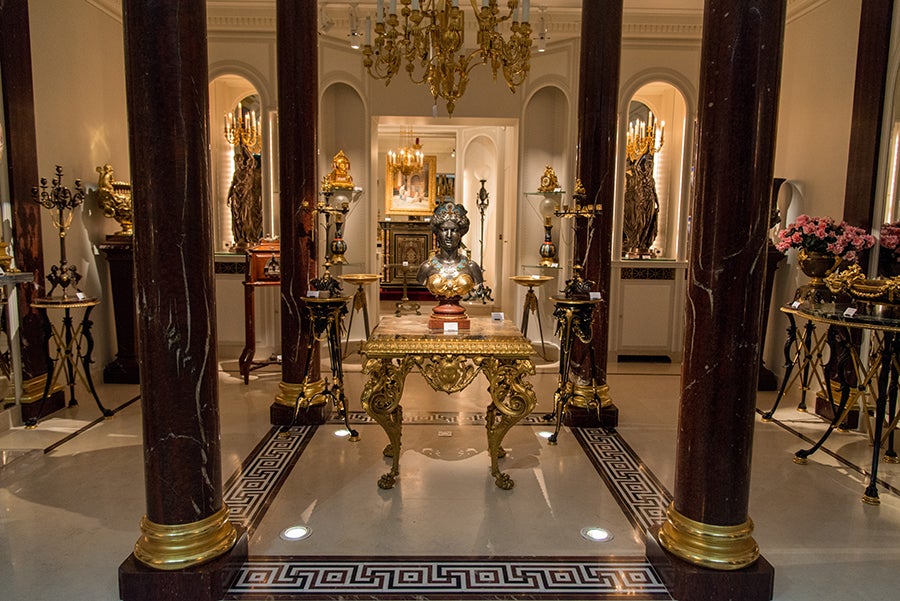
About the Seller
4.9
Vetted Professional Seller
Every seller passes strict standards for authenticity and reliability
Established in 1997
1stDibs seller since 2018
87 sales on 1stDibs
Typical response time: 1 hour
Associations
International Confederation of Art and Antique Dealers' Associations
- ShippingRetrieving quote...Shipping from: Saint Ouen, France
- Return Policy
Authenticity Guarantee
In the unlikely event there’s an issue with an item’s authenticity, contact us within 1 year for a full refund. DetailsMoney-Back Guarantee
If your item is not as described, is damaged in transit, or does not arrive, contact us within 7 days for a full refund. Details24-Hour Cancellation
You have a 24-hour grace period in which to reconsider your purchase, with no questions asked.Vetted Professional Sellers
Our world-class sellers must adhere to strict standards for service and quality, maintaining the integrity of our listings.Price-Match Guarantee
If you find that a seller listed the same item for a lower price elsewhere, we’ll match it.Trusted Global Delivery
Our best-in-class carrier network provides specialized shipping options worldwide, including custom delivery.More From This Seller
View AllRenaissance Style Wooden Cabinet Attributed to H.A. Fourdinois, France, 1893
Located in PARIS, FR
A wooden cupboard, elaborately carved throughout, dated "1893" on the crest and attributed to H.A. Fourdinois. The upper section with a pair of cherubs at the center of a balustrade ornamented with two-handled urns, two architectonic doors below, carved with lady and gentleman in niches surrounded by extensive carving with classical motifs. The lower section with two drawers above a standing female caryatid support at each front corner. The all reposing on four gadronned round feet.
The Fourdinois company was founded in 1835 by Alexandre-Georges Fourdinois (1799-1871). The Universal Exhibition held in London in 1851 was undoubtedly their first great artistic and public success. Winning the Great medal for a neo-Renaissance buffet...
Category
Antique 1890s French Renaissance Cabinets
Materials
Wood
$15,373 Sale Price
40% Off
Neo-Renaissance Cabinet by G.F. Quignon, Universal Exhibition of Paris 1889
By Frederic Gustave Quignon
Located in PARIS, FR
Presented at the Universal Exhibition of Paris in 1889
Important sculpted and engraved natural wood, patinated bronze and Griotte de Campan red marble inlaid Neo-Renaissance style cabinet.
The upper part is composed of a frieze of bronze medallions separated by triglyphs and supported by ribbed columns with Corinthian capitals. There are eight of these columns paired at the front and two simple columns at the rear. The facade presents an alternation of bronzes in niches and cartouches, of marble slates in cartouches sometimes flanked by palmettes, and of engraved motives of laurel and foliage scrolls. The upper part opens with three leaves and three mobile compartments. The belt carved with acanthus leaves opens with two drawers. This cabinet is supported by four richly sculpted tapered feet ending with claws. Four fluted pilasters are inscribed in the moulded back as counterparts. The whole ensemble stands on a moulded plinth and eight rounded feet.
Neo Renaissance Cabinet...
Category
Antique 1880s French Renaissance Cabinets
Materials
Marble, Bronze
$125,786 Sale Price
20% Off
Renaissance Style "Four Seasons" Cabinet by M. Lerolle, France, Circa 1890
By Lerolle
Located in PARIS, FR
Signed " Meubles D’Art, M. Lerolle, Fabricant, 61, Rue des Sts-Peres. Paris "
Remarkable carved wood cabinet, richly sculpted in the Neo-Renaissance style, and inlaid with vert de m...
Category
Antique 1890s French Renaissance Revival Cabinets
Materials
Marble
Neo-Renaissance Cabinet by P. Sormani and attr. to E. Lièvre, France, Circa 1870
By Edouard Lievre, Paul Sormani
Located in PARIS, FR
Signed twice on the lock P. SORMANI 10 rue Charlot Paris
Rare neo-Renaissance cabinet in carved wood and Portor marble, adorned with chiseled and gilded bronze.
The upper, part, surmounted by a frieze of posts and marble cabochons, consists of a central door decorated with a carved panel representing the birth of Venus, framed by two pairs of ringed and fluted columns with Corinthians capitals in gilded bronze revealing two doors with secret opening. Two drawers with lion’s head shaped handles and a central drawer decorated with tracery in gilded bronze complete the upper part of this cabinet.
In the lower part, two drawers on the belt with diamond...
Category
Antique 1870s French Renaissance Cabinets
Materials
Marble, Bronze
$63,359 Sale Price
38% Off
Renaissance Style Cabinet, France, Circa 1870
Located in PARIS, FR
An outstanding carved cabinet in the Renaissance style. The upper part consists in two stages with arcades, divided in six compartments by rich columns with Corinthian capitals, and topped by a carved entablature. The lower part opens with three doors, ornated with masks, hybrid figures and foliates, and relies on four strong feet.
This cabinet, probably executed for an amateur or a collector, is a perfect model for the neo-Renaissance style, that rose in the 1830’s, in France with the designers Claude-Aimé Chenavard (1798-1838) and Michel Liénard (1810-1870). It came some years after the Gothic Revival, but met a longer success during the 19th century (at the Expositions des Produits de l’industrie in 1844 and 1849, and at the Universal Exhibitions in 1855, 1867 and 1878). Inspiration was found in the French Renaissance, more specifically in the art of Henri II’s reign, and cabinet-makers used dark carved...
Category
Antique 1870s French Renaissance Cabinets
Materials
Wood
Wooden & Enameled Display Sideboard Attributed to H.A Fourdinois, France, c1867
Located in PARIS, FR
Important two-tiered sideboard attributed to H.A. Fourdinois made in natural and carved wood : the lower part made up of four panels, two concave ones and two doors, richly ornated with a polychrome enameled floral decoration and gilt bronze plaques.
A large dual drawer is surmounted by the upper part of the sideboard, opening with two glazed doors, framed by detached columns. The entire unit is topped with a pediment onto which a female bust is carved in relief within a medallion on a gilt background.
With a matching set of twelve chairs.
The Forney library in Paris preserves order registers of the Fourdinois as well as sketches books and pictures representing pieces of furniture made by the Fourdinois workshops. In this documentation, some elements enable us to link this sideboard with Henri-Auguste Fourdinois’ productions, such as the large scrolls linking the upper part to the lower part of the sideboard, as well as the detached columns carved at their lower third. (picture n°1 attached)
Notebook containing ink-sketches coming from the Fourdinois workshop shows a project for a pelmet, beautified with a centering trophy composed of a torch and a quiver within in a foliage wreath, this motif obviously reused by the Fourdinois on the central decoration of the panels of our sideboard. (picture n°2 attached)
The firm of Fourdinois, considered during the Second Empire as the greatest furniture manufacturer in Paris, was founded in 1835 by Alexandre-Georges Fourdinois (1799-1871). It was developped in the context of the Expositions Universelles. At the time, the firm already produces furniture of the Neo-Renaissance style, such as a dresser that won the Great Medal at the London Universal Exhibition of 1851. The son, Henri-Auguste Fourdinois (1830-1907), joined the firm in 1860 and will become head of the firm in 1867. The high quality of his designs was remarked at the Universal Exhibition in 1862, when the jury awarded him two medals « for Excellence of Composition and Execution ». Henri-Auguste, now sole in charge, brought the firm to the summit of its achievements at the 1867 Universal Exhibition in Paris by winning the Grand Prize for his stand. Apart from the commissions he executed for the « Mobilier de la Couronne », he also produced high quality furniture for the Parisian bourgeoisie. The firm is at its zenith during the years 1862-1880. At this time, it is considered as an example to follow for other cabinet-makers, whether they are French, British or American.
Through the quality of execution and the extreme care taken in the decoration of furniture, H.-A. Fourdinois was particularly appreciated by Napoleon III and Eugenie...
Category
Antique 1860s French Renaissance Sideboards
Materials
Enamel, Bronze
You May Also Like
Exceptional Neo-Renaissance style dining room set made out of carved walnut.
By Louis-Constant Sevin, Ferdinand Barbedienne
Located in SAINT-OUEN-SUR-SEINE, FR
Eugène Frager, Meynard Manufacture (cabinetmaker), Ferdinand Barbedienne (bronze manufacturer), Louis-Constant Sevin (ornemanist) - Exceptional Neo-Renaissance style dining room set ...
Category
Antique 1890s French Renaissance Revival Furniture
Materials
Marble, Bronze
19th Century French Renaissance Hunt Vaisselier Buffet
Located in Dallas, TX
19th Century French Renaissance Hunt Vaisselier Buffet was artistically sculpted to celebrate the bounty of the earth, and perform a display, serving...
Category
Antique 1850s French Renaissance Revival Buffets
Materials
Oak
Neo-Renaissance Style Buffet, Napoleon III Period
Located in Saint-Ouen, FR
Small walnut Renaissance style two-tiered buffet or sideboard, opening with two door leaves in the lower part and one door leaf in the upper part, two drawers in the middle. The whol...
Category
Antique Late 19th Century Renaissance Revival Buffets
Materials
Walnut
19th Century Renaissance Style Belgian Buffet À Deux Corps or Cabinet
Located in Winter Park, FL
A 19th century buffet à deux corps from Belgian. Made of solid oak in two parts, the top has arched glass paned doors and opens to four removable shelves and the bottom opens to two ...
Category
Antique 19th Century Belgian Renaissance Buffets
Materials
Brass
Neo-Renaissance Cabinet, Late 19th Century
Located in Greding, DE
A four-door cabinet in Renaissance style standing on ball feet with lion's head mascarons and half-columns with volute capitals. The doors with panels and vine decoration are separat...
Category
Antique 19th Century German Renaissance Revival Cabinets
Materials
Wood
1800's Antique Buffet A Deux Corps, French Renaiss. Revival, Figural, Marquetry
Located in Austin, TX
Stunning Antique Buffet A Deux Corps, Server, French Renaissance Revival, Figural, Marquetry, 1800s, 19th Century!
This stunning antique b...
Category
Antique 19th Century French Renaissance Revival Buffets
Materials
Wood
More Ways To Browse
Antique Dining Room Sets
Antique Drawing Room Furniture
Antique Dining Room Sideboard
Asian Women
Display Sideboard
Wood Pediment
Renaissance Paris
Asian Styled Dining Set
Antique Wood Pediments
Room Divider Gold
Renaissance Wood Panels
Glass Door 1890
Universal Furniture Dining Room Sets
Antique French Room Divider
Marble Chair Company
Renaissance Neo Furniture
French Panel Room Divider
Century Furniture Asian Sideboard
